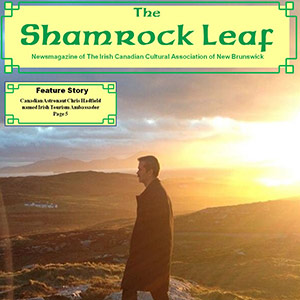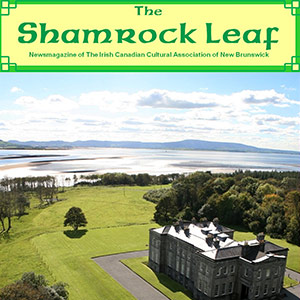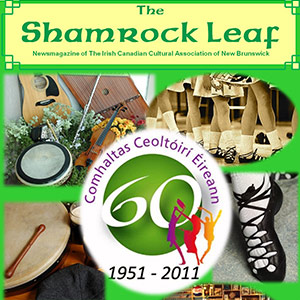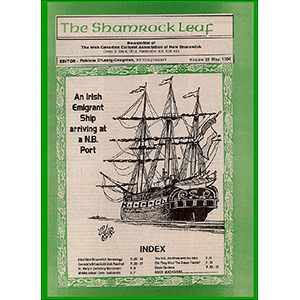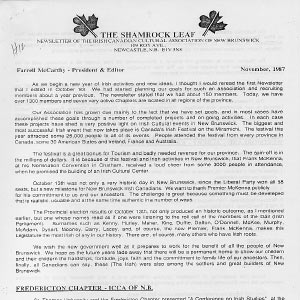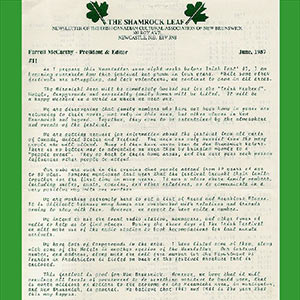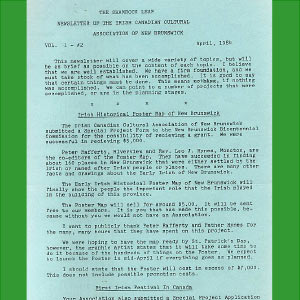IRISH CANADIAN CULTURAL ASSOCIATION OF NEW BRUNSWICK (ICCANB)
CONTACT INFORMATION
The structure of the ICCANB includes a provincial body under which the Association is incorporated, and, for administrative purposes, 5 Chapters located around the province, (Category A) serving the Association members within their regions.
Members from other provinces, countries or areas within New Brunswick which are not within the area of an existing Chapter are considered members at large (Category B and are serviced directly from the provincial body.
For better service, please note the contact information below, based on your membership category:
ICCANB REGIONAL CHAPTER CONTACT INFORMATION
(for Category A – local New Brunswick members)
Email, regular mail and telephone contacts for regional Chapters can be found on this site under the individual Chapters at:
https://iccanb.ca/about-us/chapters
ICCANB PROVINCIAL BODY CONTACT INFORMATION
(for Category B – members at large and for non-members looking for information)
![]()
PHONE:
1-506-357-8283
![]()
REGULAR MAIL:
c/o 7 Hatch Street
Oromocto, NB
E2V 2L3
CANADA
Irish-New Brunswick Facts & Trivia
Saint John
| The first three Bishops of the Diocese of Saint John were natives of Ireland – William Dollard (far left) of Mooncoin, County Kilkenny, Thomas L. Connolly of Cork (left centre) and John Sweeny (right), of Clones. All were visionaries and builders. |
| 1849 Timothy Warren Anglin (left) – Born in Clonakilty, County Cork, immigrated to NB in 1849. He founded “The Freeman” newspaper, perpetuated today as “The New Freeman” a Catholic Diocesan Weekly. He later served as a member of the Provincial Legislature and of the House of Commons, where he became the first and only speaker from NB. His daughter Margaret became a noted stage actor in the United States at the turn of the century and his eldest son, E.A. Anglin, became a distinguished member of the Supreme Court of Canada.
Shirley Dysart (right), the first elected woman MLA from Saint John, went on to become the first woman interim leader of the Liberal Party, the First woman Minister of education and the first woman Speaker of the House. Robert J. Higgins, Leader of the New Brunswick Liberal Party, was the first Irish Catholic from Saint John to be elected to lead a provincial political party. 1993 Thomas J. Higgins, was the first elected Irish Catholic Mayor of Saint John, 1993 – 1995. |
| Sister Honoria Conway (left), a young Galway-born novice serving in New York, was among the first to respond to Bishop Connolly’s calls for assistance, and it was under her leadership, in 1854, the widely-respected teaching and nursing order, the Sisters of Charity was formed in Saint John.
Dr. James Patrick Collins, (right) a native of Cork, volunteered to help treat fever victims on Partridge Island shortly after setting up his medical practice at York Point. Three weeks after arriving on the island to assist Doctors George J. and William S. Harding, he contracted typhus and succumbed “a martyr to his duty”, on 2 July 1847 at the age of 23 years. |
| 1836: Michael Flood emigrated from County Kildare in 1836. In 1848 he started what has become Canada’s oldest construction company, now John Flood & Sons (1961) Ltd.
Samuel Perry McCavour, of Irish ancestry, who settled in Lorneville, was comptroller of currency from 1925-1930, and as such, his signature appears on Canadian banknotes of that period. E.J. Henneberry, who later became one of the city’s best-known Provincial Court Magistrates, was elected to the Legislature in 1935 and became president of the Executive Council. Ralph McInerney was elected to the Legislature in 1939 and George McInerney, along with long time school principal Arthur W. Carton, followed in the 1950s. All were from Saint John. |
1780 – Fort Howe:Saint John had a blockhouse and garrison commanded during the American Revolution by Capt. Gilford Studholme, a native of Ireland. A full-size replica of Fort Howe was constructed in Saint John in 1967. |
1819 – Saint Patrick’s Society: The Saint Patrick’s Society in St. John was founded in 1819 for “Gentlemen of Irish descent”. In its early years it provided financial and other assistance for new immigrants from Ireland. The original Society dissolved in the 1880s but was revived in 1929. The Presidency alternates between a Protestant and a Catholic each year.
1843 – Saint John’s first “Irish Free Presbyterian Church” was founded in 1843 when the St. John Congregation, wanting a minister from Ireland, separated from the Scottish-based St. Andrew’s Congregation. Their first minister, Rev. Robert Irvine, came from Ballynahinche in 1844.
1847 – Partridge Island: This historic gateway to Saint John can be viewed in the distance from almost any part of the waterfront. Guardian of Saint John Harbour, Partridge Island was named by the French explorer Samuel de Champlain, and has a long immigration, quarantine and military history. The 10 hectare (24-acre) island was designated as a quarantine station in 1785, making it the first such station in North America. Floods of Irish and other immigrants passed through this “Ellis Island of Canada,” and it also served as a military base. The quarantine station was inundated with “Famine Irish”, reaching the peak in 1847. It closed in 1941 and military operations ceased in 1947. The island has been declared both a National and Provincial Historic Site.
1997 – Comhaltas Ceoltóirí Éireann: The Saint John branch of this International organization is formed. It is devoted to the preservation and promotion of traditional Irish dance and music. With an active membership, it holds regular musical Sessions as well as participating in workshops with international performers and instructors.
Irish-New Brunswick Facts & Trivia
Northumberland County
Chatham
| 1846: Patrick Carroll, & James and Patrick Desmond were master ship-builders for many of the ships built in the shipyards.The first Irish Born to receive political prominence on the Miramichi was Martin Cranny of Chatham, who in 1846, was elected to the House of Assembly.
Others who followed included Thomas Gillespie, a native of Mallow, County Cork, who was President of the Executive Council in the Conservative administration of Andrew Blair (late 1800s).
|
Rev. John Sweeny, in 1847, Pastor of St. Michael’s Parish in Chatham, built a small rectory and its future functions read like the official history of the town: Episcopal residence, first Hotel Dieu Hospital, the starting point of St. Thomas College, St. Joseph’s Preparatory School for boys and the convent of the Religious Hospitalliers of St. Joseph. |
Born in Chatham of Irish parentage, Patrick James Riordon became an early Bishop of San Francisco and his cousin, also Chatham born, D. Dunne became the Bishop of Chicago.
Newcastle
Patrick Hennessey, who came with the Famine Irish in 1853, established a grocery business which grew into a large wholesale & retail trade.
John Daniel Creaghan, from County Cork, who arrived in 1875, founded the company that bore his name.
John Morrissey, also a native of Ireland, was a merchant and political figure who was elected to the Legislative Assembly in 1903 and 1908 and served as Minister of Public Works. At one time he was also President of the Board of Trade.





